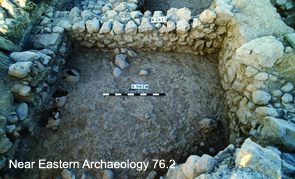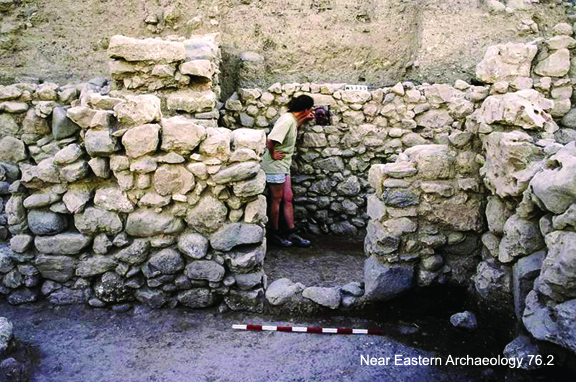ANE Today Editorial Introduction:*
Few topics are more controversial than the biblical kingdoms of David and Solomon. Were they and their rulers real, and if so, what archaeological remains did they leave? Or were they literary creations, exaggerations or even fabrications of later biblical writers? The arguments have raged for almost three decades without end, polarizing biblical Archaeology—and the public—like no other issue.
Hazor has long played a central role in both arguments. Below, Amnon Ben-Tor, the current excavator, describes the well-planned 10th century remains. Are these indications of the kingdoms of David and Solomon, or just remains of a small Iron Age city?
By: Amnon Ben-Tor, Hebrew University of Jerusalem,
Edited and abridged from NEA 76.2: 101-109
Yigael Yadin’s excavations at Hazor in the 1950’s played a crucial role in the development of the “Archaeology of the United Monarchy.” The first Iron Age fortification system of the site, consisting of a six-chambered gate and the attached casemate wall, was uncovered on Hazor’s acropolis by Yohanan Aharoni and were dated to the middle of the tenth century BCE. The similarity of the Hazor gate at to gates at Megiddo and Gezer led Yadin to propose this was confirmation of 1 Kgs 9:15: “This is the account of the forced labor that King Solomon conscripted to build the house of the Lord and his own house, the Millo and the wall of Jerusalem, Hazor, Megiddo, Gezer.” Yadin’s conclusions regarding the Iron Age strata at Hazor were accepted by a majority of scholars, although some accepted them only partially or even totally rejected them.
The controversy has intensified over the last two or three decades, since the issue has become part of a larger debate on the historical reliability of the Bible. One group of scholars today, led by Israel Finkelstein, doubt or even totally negate the very existence of a political entity centrally governed from Jerusalem that can be defined as the United Monarchy. If there was no central government in Jerusalem (no United Monarchy), so the argument goes, then there would have been no one who could have initiated and financed large-scale building activities such as the construction of the fortifications at Hazor, Megiddo, and Gezer. Consequently, the dates of these building activities should be lowered to the ninth century BCE, the time of the kingdom of Israel.
The historical reliability of the Bible is certainly beyond the scope of this article, as is the archaeological dating of gates at Megiddo and Gezer. But one of the goals of the renewed Hazor excavations is to reexamine and reevaluate Yadin’s conclusions, including the Iron Age fortifications.
Hazor in the Tenth Century BCE

Remains from Yadin’s excavations showing the Pillared Building and the underlying multi-roomed structure.
Hazor was extended considerably in the ninth century BCE (Stratum VIII) to include the eastern half of the acropolis. The earlier six-chambered gate and casemate wall, however, continued in use: the gate was used as an internal gate separating the two parts of the acropolis, and the rooms in the casemate wall were used as storage facilities or, in some cases, as living quarters. All of these features were excavated by Yadin’s expedition down to their foundations, so it was impossible for us to reexamine them. However, there are two places where a reexamination was possible. The first is a structure, only partially excavated by Yadin, located under the famous Pillared Building. The second is the northernmost room in the casemate wall on the edge of Hazor’s acropolis facing the Lower City. The Pillared Building is a public storage facility, part of which was initially excavated in the 1920’s by British archaeologist John Garstang. The structure was completely cleared by Yadin and attributed to the ninth century BCE. An earlier multi-roomed structure partially underlies and extends beyond the northern edge of the Pillared Building.
This part of the structure was excavated by Yadin’s expedition, which discerned four phases of occupation. Since the Pillared Building was not removed, only part of the underlying structure could be investigated during the 1950s. Over the years, the Pillared Building suffered considerable damage due to exposure to the elements. As part of the preservation and restoration work carried out at Hazor by the present expedition, the Pillared Building was carefully dismantled and rebuilt at another location on the site. Not only did this save the building, but it also gave us the opportunity to expose completely the rest of the structure buried beneath it.
Like Yadin, we found four stratigraphic phases expedition. The rich ceramic assemblages found on the floors of the various rooms date to the tenth century BCE.
A pebble-paved alley separates the newly excavated multi-roomed structure from the casemate wall to the east. The pavement confirms the dating of all three architectural features—the architectural complex, the casemate wall, and the six-chambered gate (which is bonded to the casemate wall)—to the tenth century.In Area M, located in the northernmost area of the acropolis, Yadin attempted to find the juncture of the two fortification systems: one built in the tenth century BCE (Stratum X) and another built in the ninth century BCE (Stratum VIII). The floor of the northernmost casemate room was the only one uncovered by Yadin. When excavations were resumed in 1990, another floor, the earliest one in this room, was discovered.
The pottery from this floor dates to the tenth century BCE, as a bichrome jug and cooking-pot rims confirm. The reexamination of the northernmost casemate room lends support the tenth-century BCE date of Hazor’s first Iron Age fortification system.
In addition to the fortifications, parts of the residential quarters were uncovered by Yadin and the renewed excavations. The multi-roomed structure, clearly residential in nature, was separated from the casemate wall by an alley running north-south. The entrances to the buildings of the architectural complex are located along that alley. Further south, an alley running in east-west separates two residential units from one another. One of those buildings is exceptionally preserved, with walls still standing to a height of nearly 2 meters. A small window is the only such feature found at Hazor thus far.
This arrangement of peripheral and radial streets/alleys separating the clusters of residential buildings from one another is another indication of a very sophisticated city plan already in place during this early stage of the city’s existence.
Conclusion
Tenth-century BCE Hazor was thus a well-planned city, of a sort that implies a central authority. Only the western portion of Hazor’s acropolis, measuring some 6.5 acres, was settled during the tenth century BCE. Yet this “embryonic” city with its fortifications, well-built houses, and sophisticated city planning is a worthy fore-runner of its successor, Israelite Hazor of the ninth century BCE, when the city grew and became an important administrative center during the days of the Omride dynasty.
* The Editorial Introduction in italics is written by the ANE Today Editorial Team and not by Professor Ben-Tor.
Photo Gallery: Here’s a gallery of all the images that appear in Near Eastern Archaeology 76.2 for Hazor in the Iron I and Iron IIa Ages. Smaller versions of some of the images also appear in the text above to illustrate the abridged version of the article found on the ASOR Blog / ANE Today.
If you liked this article please sign up to receive The Ancient Near East Today via email! It’s our FREE monthly email newsletter. The articles will be delivered straight to your inbox, along with links to news, discoveries, and resources about the Ancient Near East. Just go here to sign up.
All content provided on this blog is for informational purposes only. The American Schools of Oriental Research (ASOR) makes no representations as to the accuracy or completeness of any information on this blog or found by following any link on this blog. ASOR will not be liable for any errors or omissions in this information. ASOR will not be liable for any losses, injuries, or damages from the display or use of this information. The opinions expressed by Bloggers and those providing comments are theirs alone, and do not reflect the opinions of ASOR or any employee thereof.








Pingback: Hazor in the10th Century BCE was Solomonic | Reality 1.0
Pingback: links to the land | preachersmith